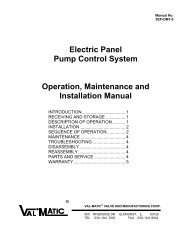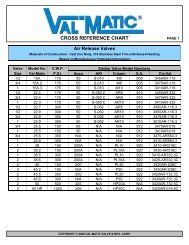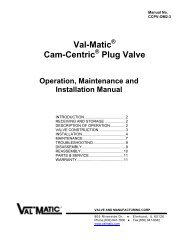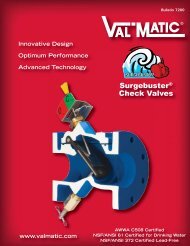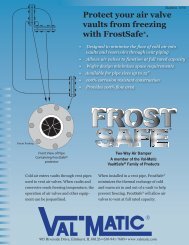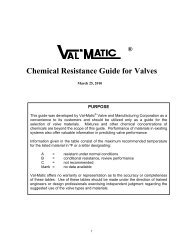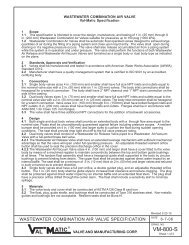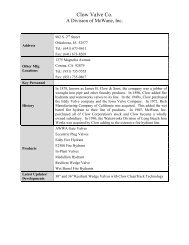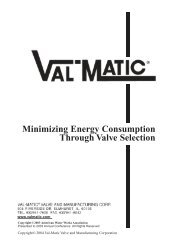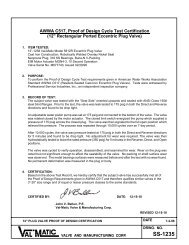Manual Actuators.pdf - Val-Matic Valve and Manufacturing Corp.
Manual Actuators.pdf - Val-Matic Valve and Manufacturing Corp.
Manual Actuators.pdf - Val-Matic Valve and Manufacturing Corp.
Create successful ePaper yourself
Turn your PDF publications into a flip-book with our unique Google optimized e-Paper software.
®<strong>Manual</strong> <strong>Actuators</strong>VAL-MATIC VALVE AND MANUFACTURING CORP.905 RIVERSIDE DRIVE, ELMHURST, IL 60126TEL. (630) 941-7600 FAX. (630) 941-8042www.valmatic.com
MANUAL ACTUATORSINTRODUCTIONButterfly <strong>and</strong> ball valves are typically supplied with either a traveling nut or worm geartype actuator. Both types are listed in the applicable AWWA <strong>Val</strong>ve St<strong>and</strong>ards, C504<strong>and</strong> C507. Each type has some important characteristics that affect the performanceof the valve assembly <strong>and</strong> should be understood before selecting the best gear for aparticular application.TRAVELING NUT ACTUATORSThe first type of actuator often provided is the traveling nut actuator. It has beenaround for over 50 years <strong>and</strong> is provided in two designs: the slotted lever <strong>and</strong> the linklever.The traveling nut actuator was created to match the torque characteristics ofbutterfly <strong>and</strong> ball valves, which may have high seating torque on small to mediumsized valves. Therefore, a higher mechanical advantage at the end of travel is oftendesirable.The traveling nut actuator consists of asealed housing, threaded stem, threadednut, link, <strong>and</strong> lever. As the threaded rod isturned with the h<strong>and</strong>wheel, the nut is drivento the left <strong>and</strong> right <strong>and</strong> supported by milledslots in the housing <strong>and</strong> cover of theactuator. The nut in turn drives the link <strong>and</strong>lever. When the nut is on the left side of theNUThousing in the photo, the link is near thevertical orientation. At this location, travelof the nut provides a small change in leverrotation. Hence, at the left end(closed position) the mechanical advantageof the actuator can be twice that in the center or right position. The traveling nut geartherefore matches the torque requirements of the valve. A traveling nut operation canvary from 10 to 100 turns <strong>and</strong> for large valves (i.e. greater than 36 in.), spur gears orbevel gears are provided.The closed <strong>and</strong> open stops of these actuators are typically threaded nuts that arepinned to the threaded stem. Because, a high amount of torque can be resistedbetween two nuts jammed together <strong>and</strong> because the stop design does not apply aload to the housing, the stops are usually rated to 450 ft-lbs. This high torque ratingprevents many valve failures in buried service. <strong>Val</strong>-<strong>Matic</strong> offers a special externallyadjustableclosed stop where the adjustment nut extends through the housing for easyaccess.1VALVESHAFTCLOSEDSTOP
Traveling nut actuators are usually constructed of an iron housing, steel links, <strong>and</strong> aductile iron lever <strong>and</strong> are more economical that worm gear actuators. They are moreeconomical than worm gears because the bronze worm gear is not needed <strong>and</strong> theyprovide their greatest mechanical advantage at the closed position to match therequirements of the valve. Traveling nut actuators are the st<strong>and</strong>ard actuator for mostAWWA butterfly <strong>and</strong> ball valve manufacturers. These actuators are designed <strong>and</strong>made by each valve manufacturer <strong>and</strong> designed specifically for these valves.WORM GEARSEarly butterfly <strong>and</strong> ball valves wereprovided with worm gear type actuators,which feature a sealed iron housingcontaining a hardened steel worm thatdrives a large worm gear, sometimescalled a segment or sector gear.Adjustable bolts are provided to limit thetravel of the actuator <strong>and</strong> preciselyposition the valve in the open <strong>and</strong>closed positions.A basic worm gear converts about 20turns of the input shaft into the 1/4 turnnecessary to operate the butterfly valve.This operation translates into amechanical ratio of about 80:1.WORMVALVESHAFTHowever, with consideration to the friction in the gear faces, the efficiency of the gearis only about 30% resulting in a mechanical advantage of about 25:1. Hence, if ittakes 500 ft-lbs on the valve stem to operate the valve, then the input torque neededon the actuator is only 500/25 or 20 ft-lbs. When the input torque exceeds about 150ft-lbs or 80 lbs pull on the h<strong>and</strong>wheel, spur gears are provided on the input side of thehousing to provide additional mechanical advantage.Worm gears can be provided with h<strong>and</strong>wheels for above ground service or 2” AWWAnuts for buried service. For buried service, the input shaft is made corrosion resistant,the housing is packed with grease, <strong>and</strong> the indicator is replaced with a blind cover.One weakness of the worm gear is that the closed stop design is usually limited to atorque of 300 ft-lbs because all of the torque is transmitted to the housing as forceagainst the stop bolt. When a valve is buried, maintenance workers can sometimesexceed that torque <strong>and</strong> damage the gear.The worm gear is a reliable gear <strong>and</strong> is available from many alternate suppliers.However, its cost can be high given that its torque linear characteristic does not matchthat of the valve. It also provides external closed stop adjustment, which can behelpful in above ground applications.2
ACTUATOR OPERATING CHARACTERISTICSThe last important consideration in selecting an actuator is the different operatingcharacteristic of the two types. The worm gear has a linear characteristic whichmeans that for every turn of the h<strong>and</strong>wheel, the valve is rotated the same amount.The traveling nut actuator, on the other h<strong>and</strong>, exhibits “characterized closure.”Characterized closure means that during the first half of closure, the valve is rotatedrapidly, <strong>and</strong> during the last half of travel, the valve is rotated slowly toward the closedposition. This difference in travel is a result of the geometry of the link <strong>and</strong> levermechanism. The benefit of characterized closure is that the valve is closed during itslast portion of travel slowly, which can reduce pipeline surges or water hammer.Traveling Nut vs. Worm Gear100%90%80%70%<strong>Val</strong>ve Position (% Open)60%50%40%30%Worm Gear20%Traveling Nut (LS)10%0%0% 10% 20% 30% 40% 50% 60% 70% 80% 90% 100%Actuator Stroke3
CONCLUSIONIn the municipal valve business, about 75% of the manual actuators provided todayare of the traveling nut type. Traveling nut actuators are more economical than wormgears, withst<strong>and</strong> higher input torques, <strong>and</strong> provide characterized closure. Given all ofits advantages, we expect the traveling nut actuators to continue to be the dominantactuator for butterfly <strong>and</strong> ball valves.4



